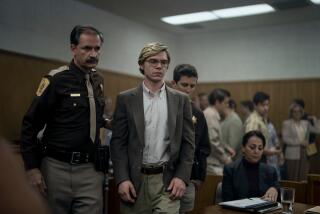North Carolina Blacks Pray for End to Crime : Violence: Of those charged in violent felonies, about 70% are black. About 12% of the population, blacks are the victims in half of all homicides.
- Share via
CHARLOTTE, N.C. — Slightly stooped and dressed all in black, Eddie Byers is out of step with the sharply tailored men and women who have tumbled out of their office buildings for a sunny lunchtime stroll.
The stunning arrest of Henry Louis Wallace, a suspect in the serial murders of at least 10 young women, already has begun to fade as this city on the verge of radiant spring resumes its gentler rhythms.
Byers, though, stands very still. Here, smack in the middle of town, he is eventually joined by a few other regulars, and together they join hands in a brief, quiet vigil against black-on-black crime.
The brutal truth is that Henry Louis Wallace is only one black man, and the young black women he is accused of strangling here are merely additions to an already lopsided set of grim statistics mirrored nationwide. Of a record 122 homicide victims in Charlotte last year, 94 were black. Of those charged with violent crimes over roughly the same period, about 70% were black.
“You take a person like Mr. Wallace and, well, there’s so much killing, so much crack cocaine going on, he’s just another grain of sand on the beach,” said Byers, who describes himself as being “from the streets.”
And so, every day at noon, they come to pray.
The Rev. Conrad Pridgeon, pastor at the Greater Bethel AME Church, is absent this day. But Robert Walton, a county commissioner, is present. So is Michael Justice, a young waiter committed to change. Sometimes, only one or two people show up. Sometimes, there are more.
But never enough, these men say. “It will take so many more to repair what’s wrong,” Walton explained before bowing to pray.
“Lord, we need healing in this here land,” he intoned as people streamed by in twos and threes, black and white, snatches of their conversations carried by the midday breeze. No one stopped to ask about their prayers.
“No one ever does,” Justice said. “Until something happens, like a Henry Wallace. That’s when people have questions. After the fact.”
Everyone wants to understand what might have driven Wallace, how he could have slipped so repeatedly through the justice system’s cracks. Might things have been different if he’d gotten help? Did the police and media pay enough attention when the bodies of young black women began turning up?
Everyone wants to know, it seems, for a few minutes.
“Then it’s back to business as usual,” Justice said, “people out here dying all the time. And no one getting to the issues. Henry Wallace isn’t the issue. He’s just easy to identify.”
The loss of life has been called epidemic. President Clinton has prevailed on black leaders to take back their streets; the Rev. Jesse Jackson has launched a similar crusade, despairing at the relief he’s come to feel when the footsteps behind him on a city street belong to someone white.
“The real point is that black people not just here but in communities all over the country are dying, in all kinds of ways, every day,” said Sandifer McCullough, finishing up a fast-food breakfast at the Bojangles where four of the strangled women worked.
“My reality is that I’m considered an old man in my community because I’m nearly 30 and I’m not rotting in jail and don’t have a bullet through my head,” said McCullough, who counsels juvenile offenders.
“My reality is that sometimes I might just be walking to a Bible study class, and the police will stop me because I’m a black man. . . . My reality is that they don’t show guys like me in the news. They show our young men wearing hoods and handcuffs.”
Violence is pervasive, and the sense of it has pushed crime to the top of white agendas. But clearly the danger is skewed: Blacks, who make up about 12% of the population, were the victims in 50 of every 100 homicides committed nationwide in 1992, according to federal statistics.
In this context, the accusations against Henry Louis Wallace are nearly dwarfed.
“It’s tough to think about, but we as citizens need to think about it that way if we’re ever really going to do anything about it,” said Harper Wilson, a special agent with the FBI.
But the daily death toll mostly goes on in silence, newsworthy not so much for its extraordinary upward spiral as for the chilling ordinariness of it all. Disproportionate arrest and murder rates, unemployment, drug abuse, poverty and racism are complex and difficult to unravel.
“So the media focus on the exceptions, the glamorous, the macabre, the bizarre, the unique,” said Dr. Carl Bell, a Chicago psychiatrist known for his work on race issues. “It’s simple-minded, stereotypical, misleading, distorted and . . . certainly isn’t helpful.”
More to Read
Sign up for Essential California
The most important California stories and recommendations in your inbox every morning.
You may occasionally receive promotional content from the Los Angeles Times.













